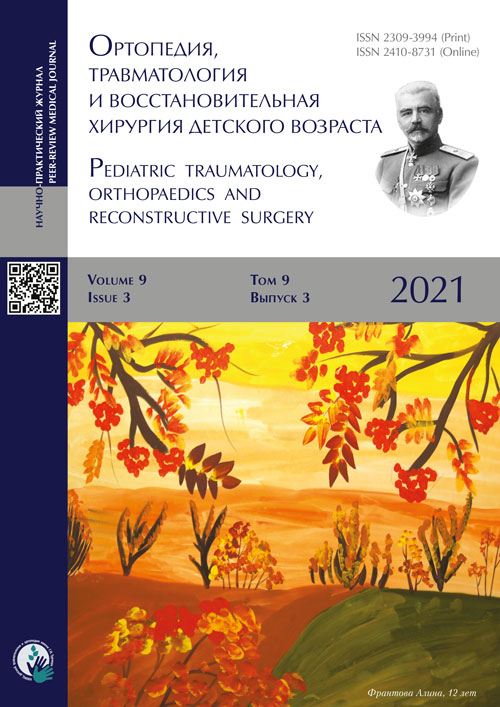外侧释放切口双侧双蒂皮瓣结合Integra®真皮再生模板的大面积腰骶部缺损闭合术
- 作者: Yap P.1,2, Mat Saad A.2,3, Wan Sulaiman W.2, Mat Johar S.2, Mohamad Shah N.2
-
隶属关系:
- Universiti Malaysia Sabah
- Universiti Sains Malaysia
- Management and Science University
- 期: 卷 9, 编号 3 (2021)
- 页面: 345-351
- 栏目: Clinical cases
- ##submission.dateSubmitted##: 02.06.2021
- ##submission.dateAccepted##: 02.09.2021
- ##submission.datePublished##: 04.10.2021
- URL: https://journals.eco-vector.com/turner/article/view/71191
- DOI: https://doi.org/10.17816/PTORS71191
- ID: 71191
如何引用文章
详细
背景。脊髓脊膜膨出是一种最复杂的先天性中枢神经系统发育畸形,是脊柱裂最常见的类型之一,涉及神经管闭合失败。脊髓脊膜膨出重建手术对整形外科和神经外科来说一直是项挑战。
临床病例。我们报告了在本中心接受治疗的一例患腰骶部脊膜膨出的新生儿。脊髓脊膜膨出由神经外科团队修复,术后患儿遗留下大面积腰骶部皮肤缺损。我们采用经外侧释放切口的双侧双蒂皮瓣成功覆盖大面积缺损,剩余的腰骶部和继发性缺损采用Integra®真皮再生模板(DRT)进行修复。自体表皮移植创面床的准备过程中,使用ACTICOAT连接负压伤口治疗(NPWT)作为主要敷料。该闭合技术提供了无张力的闭合。
讨论。我们结合双侧双蒂筋膜皮瓣技术和DRT闭合腰骶部缺损。经外侧释放切口的双侧双蒂皮瓣可减轻双侧腰部皮肤张力。DRT缩小了腰骶部缺损,NPWT敷料提供了理想的无菌环境,为新生真皮形成提供时间。利用DRT和自体皮肤移植对剩余的继发性缺损进行修复。
结论。手术结果表明,外侧释放切口双侧双蒂筋膜皮瓣与DRT伴延迟植皮联用安全有效,并为大面积暴露硬膜缺损提供长期稳定的柔软疤痕。
全文:
作者简介
Pauline Yap
Universiti Malaysia Sabah; Universiti Sains Malaysia
Email: paulineyap@live.com
ORCID iD: 0000-0002-2228-3473
MD
马来西亚, Kota Kinabalu, Sabah; 16150 Kubang Kerian, KelantanArman Zaharil Mat Saad
Universiti Sains Malaysia; Management and Science University
Email: armanzaharil@gmail.com
ORCID iD: 0000-0002-4003-6783
M.Sc., Professor
马来西亚, 16150 Kubang Kerian, Kelantan; Shah Alam, SelangorWan Azman Wan Sulaiman
Universiti Sains Malaysia
Email: wsazman@yahoo.com
ORCID iD: 0000-0002-0600-9765
M.Sc., Professor
马来西亚, 16150 Kubang Kerian, KelantanSiti Fatimah Noor Mat Johar
Universiti Sains Malaysia
Email: fatimahmj@usm.my
ORCID iD: 0000-0003-4120-4918
M.Sc.
马来西亚, 16150 Kubang Kerian, KelantanNurul Syazana Mohamad Shah
Universiti Sains Malaysia
编辑信件的主要联系方式.
Email: syazanashah@usm.my
ORCID iD: 0000-0001-6731-9962
PhD
马来西亚, 16150 Kubang Kerian, Kelantan参考
- Wallingford JB. Neural tube closure and neural tube defects: studies in animal models reveal known knowns and known unknowns. Am J Med Genet C Semin Med Genet. 2005;135C:59−68. doi: 10.1002/ajmg.c.30054
- Shim JH, Hwang NH, Yoon ES, et al. Closure of myelomeningocele defects using a limberg flap or direct repair. Arch Plast Surg. 2016;43(1):26–31. doi: 10.5999/aps.2016.43.1.26
- Botto LD, Moore CA, Khoury MJ, et al. Neural-tube defects. N Engl J Med. 1999;341:1509−1519. doi: 10.1056/NEJM199911113412006
- Greenberg F, James LM, Oakley GP Jr. Estimates of birth prevalence rates of spina bifida in the United States from computer-generated maps. Am J Obstet Gynecol. 1983;145:570−573. doi: 10.1016/0002-9378(83)91198-5
- Sahmat A, Gunasekaran R, Mohd-Zin SW, et al. The prevalence and distribution of spina bifida in a single major referral center in Malaysia. Front Pediatr. 2017;5:237. doi: 10.3389/fped.2017.00237
- Laurence KM. Effect of early surgery for spina bifida cystic on survival and quality of life. Lancet. 1974;1(7852):301−304. doi: 10.1016/s0140-6736(74)92606-3
- McDowell MM, Blatt JE, Deibert CP, et al. Predictors of mortality in children with myelomeningocele and symptomatic Chiari type II malformation. J Neurosurg Pediatr. 2018;21(6):587–596. doi: 10.3171/2018.1.PEDS17496
- Habibi Z, Nejat F. Myelomeningocele defect closure. Childs Nerv Syst. 2014;30:2001. doi: 10.1007/s00381-014-2550-0
- Kobraei EM, Ricci JA, Vasconez HC, Rinker BD. A comparison of techniques for myelomeningocele defect closure in the neonatal period. Childs Nerv Syst. 2014;30:1535–1541.
- Adzick NS. Fetal surgery for spina bifida: past, present, future. Semin Pediatr Surg. 2013;22:10−7. doi: 10.1053/j.sempedsurg.2012.10.003
- Patterson TJ. The use of rotation flaps following excision of lumbar myelo-meningoceles: an aid to the closure of large defects. Br J Surg. 1959;46:606−608.
- El-Sabbagh AH, Zidan AS. Closure of large myelomeningocele by lumbar artery perforator flaps. J Reconstr Microsurg. 2011;27:287−294. doi: 10.1055/s-0031-1275492
- Cöloğlu H, Ozkan B, Uysal AC, et al. Bilateral propeller flap closure of large meningomyelocele defects. Ann Plast Surg. 2014;73(1):68−73. doi: 10.1097/SAP.0b013e31826caf5a
- Emsen IM. Closure of large myelomeningocele defects using the O-S flap technique. J Craniofac Surg. 2015;26(7):2167−2170. doi: 10.1097/SCS.0000000000002154
- Banda CH, Narushima M, Ishiura R, et al. Local flaps with negative pressure wound therapy in secondary reconstruction of myelomeningocele wound necrosis. Plast Reconstr Surg Glob Open. 2018;6(12):e2012. doi: 10.1097/GOX.0000000000002012
- Lobo GJ, Nayak M. V-Y plasty or primary repair closure of myelomeningocele: Our experience. J Pediatr Neurosci. 2018;13(4):398–403. doi: 10.4103/JPN.JPN_40_18
- Nejat F, Baradaran N, Khashab ME. Large myelomeningocele repair. Indian J Plast Surg. 2011;44(1):87–90. doi: 10.4103/0970-0358.81453
补充文件














